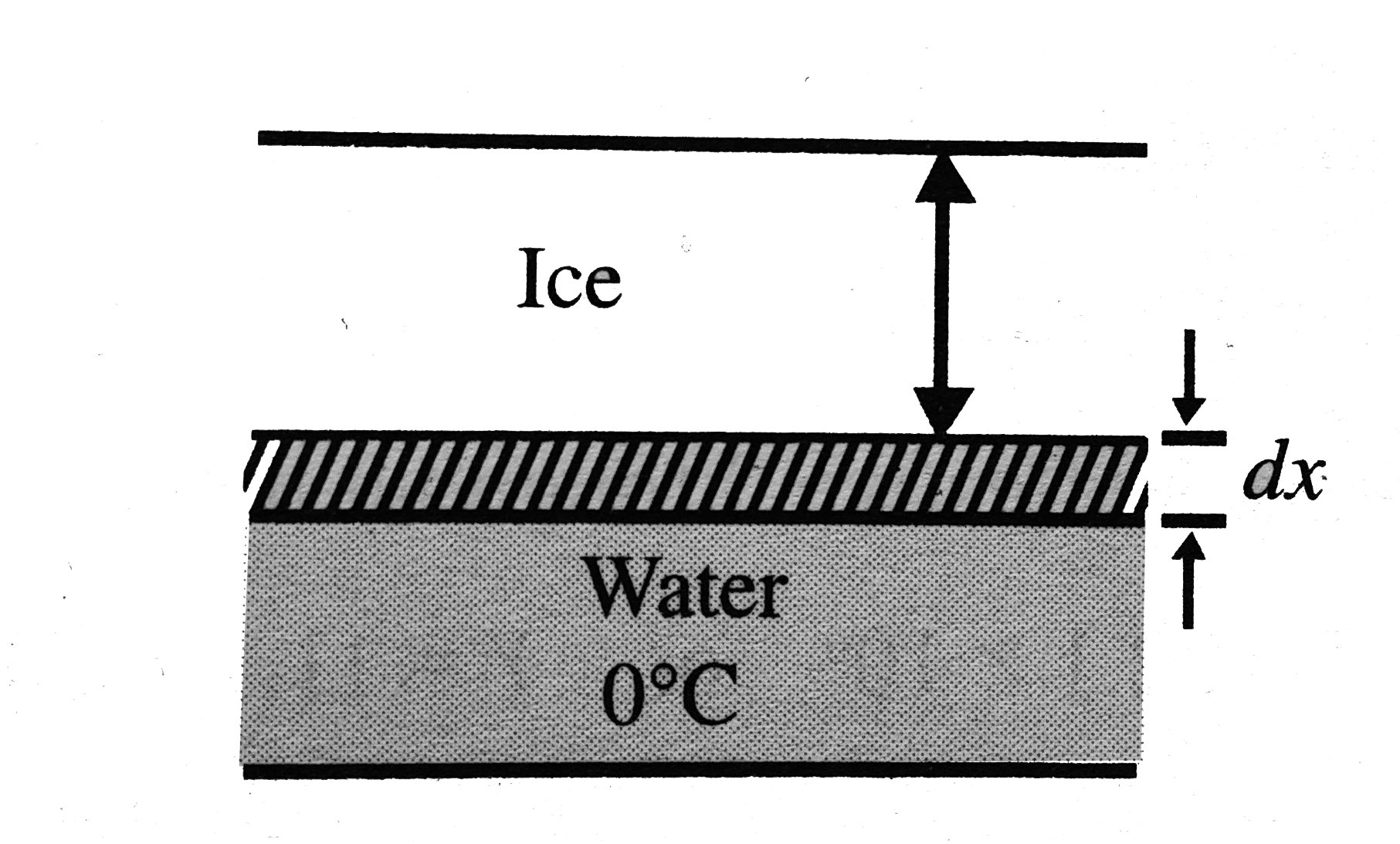A layer of ice of 0∘C of thickness x1 is floating on a pond. If the atmospheric temperature is −7∘C. Show that the time taken for thickness of the layer of ice to increase from x1 to x2 is given by
t=pL2kT(x22−x21)
where p is the density of ice, k its thermal conductivity and L is the latent heat of fusion of ice.
When the temperature of the air is less than 0∘C, the cold air near the surface of the pond takes heat (latent) from the water which freezes in the fonm of layers. Consequently, the thickness of the ice layer keeps increasing with time. Let x be the thickness of the ice layer at a certain time. If the thickness is increased by dx in time dt, thn the amount of heat flowing through the salb in time dt is given by

Where A is the area of the layer of ice and −7∘C is the temperature of the surounding air. If dm is the mass of water frozen into ice, then Q=dm×L. But dm=Apdx, where p is the density of ice. Hence
Q=ApLdx (ii)
Equating (i) and (ii). we have
KATdtx=ApLdx or dt=pLkTxds
Integrating, we have
t∫0dt=pLkTx2∫x1 or t=pLkT∣∣∣x22∣∣∣x2x1=pL2kT(x22−x11)
Topper's Solved these Questions
Similar Questions
An ice layer of thickness d1 is floating on a pond of water. The atmospheric temperature is -T∘C. What is the time taken for the thickness of the layer to increase from d1 to d2 if L, ρ and K are the latent heat of fusion of water, density of ice and thermal conductivity of ice, respectively?
View SolutionBottom of a lake is at 0∘C and atmospheric temperature is −20∘C. If 1 cm ice is formed on the surface in 24 h, then time taken to form next 1 cm of ice is
View Solution
Knowledge Check
Ice starts forming in lake with water at 0∘C and when the atmospheric temperature is −10∘C. If the time taken for 1cm of ice be 7 hours. Find the time taken for the thickness of ice to change from 1cm to 2cm
A11hoursB6hoursC16hoursD21hoursThere is formation of layer of snow x cm thick on water, when the temperature of air is −θ∘C (less than freezing point). The thickness of layer increases from x to y in the time r, then the value of t is given by
A(x+y)(x−y)ρL2kθB(x−y)ρL2kθC(x+y)(x−y)ρLkθD(x−y)ρLk2θIce starts forming in lake with water at 0∘C and when the atmospheric temperature is −10∘C. If the time taken for 1cm of ice be 7 hours. Find the time taken for the thickness of ice to change from 1cm to 2cm
A7 hoursB14 hoursC10.5 hoursD21 hours
A layer of ice of thickness y is on the surface of a lake. The air is at a constant temperature −θ∘C and the ice water interface is at 0∘C. Show that the rate at which the thickness increases is given by
dydt=KθLρy
where, K is the thermal conductivity of the ice, L the latent heat of fusion and ρ is the density of the ice.
View SolutionThe thickness of ice in a lake is 5cm and the atmospheric temperature is 10∘C Calculate the time rquired for the thickness of ice to grow to 7cm Therml conductivity for ice =4×10−3calcm−1s−1c−10 density of ice =0.92g/cm3 and latent heat of fusion of ice =80cal/g .
View SolutionIce starts forming in a lake with water at 0∘C when the atmosphere temperature is −10∘C .If the time taken for first 1cm of ice be formed is 12 minute; the time taken for the thickness of the ice to change from 1cm to 2cm will be:
View SolutionIce starts forming in lake with water at 0∘C when the atmospheric temperature is −10∘C. If the time taken for 1cm of ice be 7h, then the time taken (in hours) for the thickness of ice to change from 1cm to 2cm is
View SolutionIf layer thickness L2 is 1.4cm, then its thermal conductivity K2 will have value (in W/mK)
View Solution
